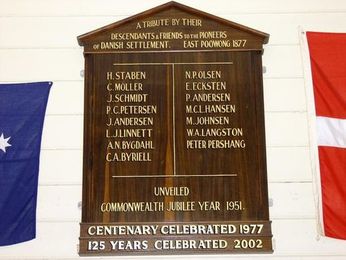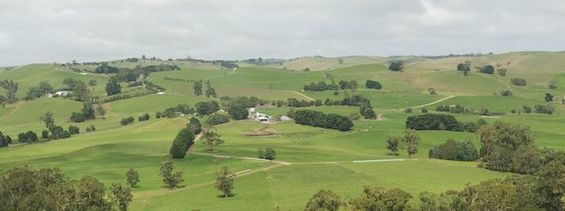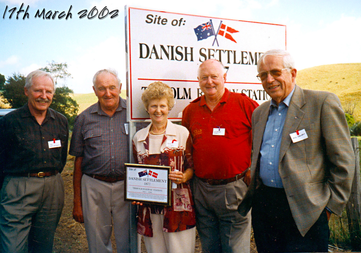the danish settlers at poowong east
By Erik Jensen, former Danish Consul General in Victoria
(excerpts from 'Danish Emigration to Australia', 1988)
(excerpts from 'Danish Emigration to Australia', 1988)
In 1877, some 12 Danes decided that gold digging was too precarious an existence and made up their minds to seek safer and "greener pastures".
They became the pioneers of the Poowong East settlement, and some of their descendants in the 4th, 5th and 6th generations continue to gather for meetings in the Community Hall at Poowong East in Victoria. However tenuous the connection, these people continue to feel some association with the country of their forefathers.
They became the pioneers of the Poowong East settlement, and some of their descendants in the 4th, 5th and 6th generations continue to gather for meetings in the Community Hall at Poowong East in Victoria. However tenuous the connection, these people continue to feel some association with the country of their forefathers.
The first danes

In the early 1870s much was written in the local papers about South Gippsland with its big forests of giant trees, fertile soil, ample rainfall and attractive climate. It had a reputation for being eminently suitable for dairy farming. This was sweet music to the ears of the Danes in the gold mining areas who were looking for more likely ways of building a future for themselves and their families.
In early 1876 two Danes in this category, J.H. Schmidt and C. Møller, took the train (which had recently been introduced) from Chewton - near Castlemaine - to Melbourne. They purchased a saddle horse and with a few basic necessities set off in search of land in Gippsland. They eventually arrived at Poowong East where a local settler showed them over the country, and they finally pegged out a selection of land. They returned to Melbourne and lodged their application with the Lands Department, and shortly thereafter they were notified that their applications would be considered at a sitting of the Lands Board in Melbourne.
They were subsequently granted an occupation licence for 3 years to the amount of One Pound per acre. After complying with these conditions and residing on the land for the 3 years, they were entitled to a lease. Under the terms of the lease they were to pay the balance due to the government of 14 shillings per acre in 14 half-yearly instalments, after which a freehold title would finally be granted.
Messrs. Schmidt and Møller's example was soon followed by other Danes in the gold fields, J. Andersen, the Byriell brothers, Mrs. Linnett and Niels Peter Olsen (who was subsequently to become the central figure in the Poowong East Settlement).
In 1877, the first task of the pioneers was to locate their land selections; then they had to find the best route for a track into the land and cut this track - no mean task through what was often dense forest.
In early 1876 two Danes in this category, J.H. Schmidt and C. Møller, took the train (which had recently been introduced) from Chewton - near Castlemaine - to Melbourne. They purchased a saddle horse and with a few basic necessities set off in search of land in Gippsland. They eventually arrived at Poowong East where a local settler showed them over the country, and they finally pegged out a selection of land. They returned to Melbourne and lodged their application with the Lands Department, and shortly thereafter they were notified that their applications would be considered at a sitting of the Lands Board in Melbourne.
They were subsequently granted an occupation licence for 3 years to the amount of One Pound per acre. After complying with these conditions and residing on the land for the 3 years, they were entitled to a lease. Under the terms of the lease they were to pay the balance due to the government of 14 shillings per acre in 14 half-yearly instalments, after which a freehold title would finally be granted.
Messrs. Schmidt and Møller's example was soon followed by other Danes in the gold fields, J. Andersen, the Byriell brothers, Mrs. Linnett and Niels Peter Olsen (who was subsequently to become the central figure in the Poowong East Settlement).
In 1877, the first task of the pioneers was to locate their land selections; then they had to find the best route for a track into the land and cut this track - no mean task through what was often dense forest.
establishing the poowong east community

All the pioneers had to leave their families behind in the gold mining areas - there is no record of how they made ends meet - and it was not until 1878 and 1879 that the Møller, Schmidt, Olsen and Staben families were reunited.
Soon the problem of schooling for their many children had to be solved. Mr Byriell offered the use of a small building on his property, provided the government would supply furniture and a teacher. This was agreed to, and some 30 children attended this first local school. The records show that school attendance was below average - little wonder, as some of the children had to walk six to eight km along tracks which were often in shocking condition and frequently blocked by logs which had to be negotiated.
During 1882 a new, small school building was built by the Education Department on land provided by Mr. Byriell - this was used extensively by the community as a school and a church (for Lutheran, Methodist, Presbyterian and Church of England services) and for public meetings, debating societies and social functions and as a polling booth at election time.
Niels Peter Olsen and his wife became the cornerstones of the early Poowong East community, and their home "Triholm" was a hospitable meeting place for all members of the community and the many outside visitors who stayed there over the years. The central role played by the original Olsen family continued by one of Niels Peter's grandsons, Wilbur Olsen, who - together with wife Amanda - occupied the "Triholm" property.
The farmers at Poowong East played a prominent role in pioneering the dairy industry in Victoria and establishing a dairy-factory in the area on a co-operative basis, following the Danish example.
A district historian, Franklin Burchett, gave due recognition to the Danish settlers in his "Memories of the Poowong District" in 1947
Soon the problem of schooling for their many children had to be solved. Mr Byriell offered the use of a small building on his property, provided the government would supply furniture and a teacher. This was agreed to, and some 30 children attended this first local school. The records show that school attendance was below average - little wonder, as some of the children had to walk six to eight km along tracks which were often in shocking condition and frequently blocked by logs which had to be negotiated.
During 1882 a new, small school building was built by the Education Department on land provided by Mr. Byriell - this was used extensively by the community as a school and a church (for Lutheran, Methodist, Presbyterian and Church of England services) and for public meetings, debating societies and social functions and as a polling booth at election time.
Niels Peter Olsen and his wife became the cornerstones of the early Poowong East community, and their home "Triholm" was a hospitable meeting place for all members of the community and the many outside visitors who stayed there over the years. The central role played by the original Olsen family continued by one of Niels Peter's grandsons, Wilbur Olsen, who - together with wife Amanda - occupied the "Triholm" property.
The farmers at Poowong East played a prominent role in pioneering the dairy industry in Victoria and establishing a dairy-factory in the area on a co-operative basis, following the Danish example.
A district historian, Franklin Burchett, gave due recognition to the Danish settlers in his "Memories of the Poowong District" in 1947
Among the many pioneers who passed through Poowong trecking eastward, were a few settlers of Danish origin. That they were satisfied with the land there can be no doubt, for the influx of their friends in force suggested that good reports had been broadcast. So numerous were these settlers that their district became known as the Danish settlement and frequently as Denmark. This fine land of pioneers made great headway by pulling together as a team.
holding on to their danish roots

In addition to the regular church services for the Poowong East community conducted by local ministers, Scandinavian pastors used to visit the community from time to time. In 1895 one of the pastors was accompanied by Captain Jens Lyng who was a well-known Danish citizen in Melbourne - for many years he edited the newspaper Norden, and he wrote several books about Scandinavians in Australia in Danish and English.
Lyng predicted that by 1977, 100 years after the original establishment of the community, the Danish character of the inhabitants would have totally vanished, except for the names.
In many ways, Jens Lyng was correct in his predictions, as visitors to Poowong East in the 1980s would have found what appeared to be a typical Australian farming community.
Nevertheless, the citizens continue to meet regularly in the Community Hall, which now features the Danish flag and a picture of Queen Margrethe II as well as Queen Elizabeth II, the Australian monarch. Danish church services continue to take place at the Poowong East Hall, most recently the current Danish pastor Bente Holdgaard held a service here in 2014.
In 1987, a 'deputation' of the Olsens, the Stabens, the Schmidts and the Johnson's travelled to Melbourne to meet Queen Margrethe II of Denmark. Some of these were sixth generation descendants of the original 'Poowong Danes' showing just how closely connected the families continue to feel with their ancestors' mother country.
Lyng predicted that by 1977, 100 years after the original establishment of the community, the Danish character of the inhabitants would have totally vanished, except for the names.
In many ways, Jens Lyng was correct in his predictions, as visitors to Poowong East in the 1980s would have found what appeared to be a typical Australian farming community.
Nevertheless, the citizens continue to meet regularly in the Community Hall, which now features the Danish flag and a picture of Queen Margrethe II as well as Queen Elizabeth II, the Australian monarch. Danish church services continue to take place at the Poowong East Hall, most recently the current Danish pastor Bente Holdgaard held a service here in 2014.
In 1987, a 'deputation' of the Olsens, the Stabens, the Schmidts and the Johnson's travelled to Melbourne to meet Queen Margrethe II of Denmark. Some of these were sixth generation descendants of the original 'Poowong Danes' showing just how closely connected the families continue to feel with their ancestors' mother country.
poowong east today

Today the farmers at Poowong East are primarily successful dairy and beef farmers.
However, not far from Poowong East, at Neerim South, another family of Danish ancestry, Robert and Lyn Johnson have developed a blue-vein cheese factory, which is now managed by their son, David together with Laurie Jensen also a Danish descendant.
However, not far from Poowong East, at Neerim South, another family of Danish ancestry, Robert and Lyn Johnson have developed a blue-vein cheese factory, which is now managed by their son, David together with Laurie Jensen also a Danish descendant.

